Explore the Nine Scenic Spots of Kowloon and Encounter Exclusive Memories of Kowloon Slope
As soon as you enter the park, you can feel the lush vegetation here.
The predecessor of Chongqing Zoo was the "West District Park", so it is not surprising that there are numerous green plants and towering ancient trees inside. There is a cuter way to say this name - "Xixi Park". It is said that it came from the accent of Chongqing people, and it is easier to call Xixi Park than Xiqu Park, so everyone quietly changed its name in tacit agreement.
Chongqing Zoo is an "urban oasis" in the city center, where animals can thrive and thrive in such a comfortable environment. For animals, it can be considered a rare paradise!
When we went this time, it was late summer, and walking in between, we could still hear some cicadas chirping.
The entire zoo is well-organized, with over 20 animal halls and more than 260 species of animals, totaling over 4000 individuals. Here, you can see rare species such as giant pandas, red pandas, antelopes, and argali. The various exhibition halls are not far apart but can not disturb each other, which is very peaceful. The animals each enjoy their own one and a half acres of land, while the pandas freely eat bamboo, roll and frolic on the grass, or hunch over tree trunks to rub and relieve itching, enjoying themselves.



The "Double Celebration" of these two giant panda twins, along with the world's oldest artificially bred giant panda - Xinxing, who is already 38 years old this year, are both big stars in the zoo. Many tourists come here to see how they usually play.
In order to provide a better living environment for giant pandas, the entire panda enclosure was built according to the mountain terrain, restoring the wild living environment as much as possible. At the same time, many scenes such as streams and caves have been artificially created. Normally, giant pandas can freely play and frolic outdoors, and at night, they can return to their artificial caves to rest.
According to the staff here, in April and May every year, this place also attracts some "uninvited" "new residents" - egrets, allowing citizens who come to the zoo to enjoy the unique harmonious scenery of humans and egrets.
I can see some citizens taking walks, practicing Tai Chi, and exercising here, treating it as a place for health and wellness with peace of mind.
The entire zoo is spacious and quiet, suitable for occasional outings to relax. In January 2009, the National Tourism Administration approved Chongqing Zoo as a national 4A level tourist attraction.
Museum Cave Heaven: A Time Travel of Air Defense CavesTicket: 50 yuan
Business hours: 9:00-17:30
mode of transportation:
1. Rail Transit: Take Rail Transit Line 2 and exit at Xiejiawan (Exit B).
2. Bus routes: 471, 207, 362, 148, 419.
Chongqing is a mountain city. During the Anti Japanese War, many air raid shelters were built here, and Jiulongpo District used them to build the Jianchuan Museum. But in the past, I only heard from the elderly and didn't personally go to see it. So this time I'm planning to go to Chongqing Jianchuan Museum to experience Chongqing's unique anti Japanese war culture.
Climbing up a long staircase, you can see the theme sculpture of Chongqing Jianchuan Museum - "Braving Enemy Fire". You can see a soldier standing tall, holding a machine gun, with a firm and open gaze. This sculpture is built next to the Egongyan Yangtze River Bridge and is the most iconic building. It symbolizes the heroic spirit of the revolutionary predecessors who fought against the war, and also indicates the determination of the revolution to eventually achieve victory.

After entering through the gate, I found that there was a hidden paradise here. This museum is made up of 32 air raid shelters, divided into 9 themed halls and 1 adjacent exhibition hall. They are the Museum of Weapon Development History, the Former Site Museum of the First Ordnance Factory (Hanyang Ordnance Factory) of the Ordnance Industry Bureau, the Anti Japanese War Cultural Relics Museum, the Chongqing Story Museum, the Folk Prayer Culture Museum, the Chinese Wedding Culture Museum, the Ticket Life Museum, the Traditional Chinese Medicine Culture Museum, the Chongqing Civil Air Defense History Exhibition Hall, and the Folk Memory Museum of the Seventy Years of New China. The museum is filled with weapons and artillery vehicles from the Anti Japanese War period, as well as daily necessities from the 1950s and 1960s. It not only embodies Chongqing's unique anti Japanese culture, but also maintains a sense of daily life.

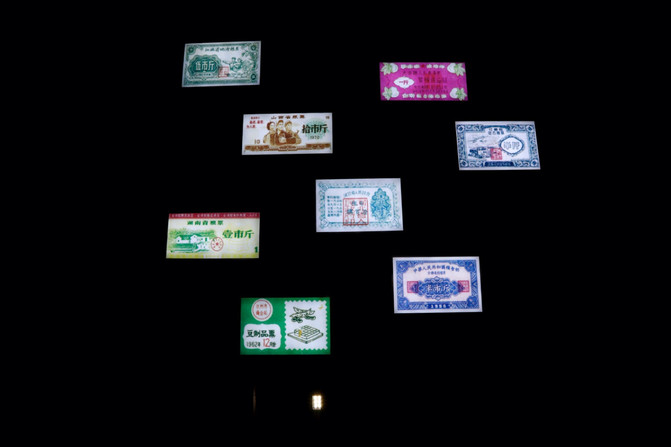

There are well preserved cave walls here. Walking inside the cave, I touched the uneven walls with my hand and felt a hint of coolness coming from my fingertips. It's hard to imagine how much weight of life these caves carried in history during times of war.
According to the staff, the museum displays over 40000 cultural relics, including 116 national first-class cultural relics and various collections of cultural relics. The cultural relics mainly include modern historical materials and items such as the Anti Japanese War, military engineering, folk customs, and the Red Era, covering the sediment of Chinese history from the Xinhai Revolution to the reform and opening up.
Among them, the one that caught my eye the most was this "death" flag.
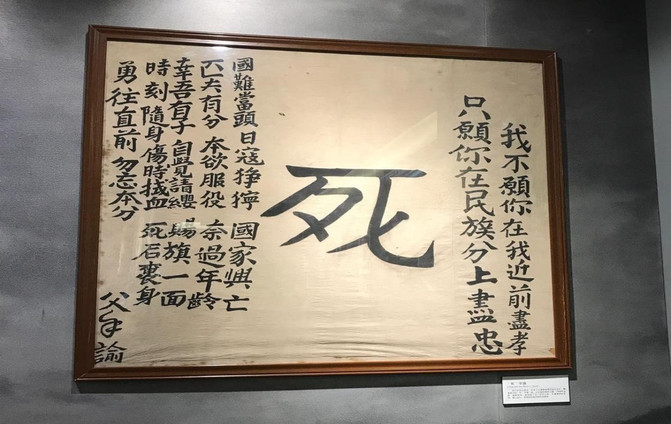
This flag was given to his son by King Cheng of Anxian County, Sichuan Province when he volunteered to kill enemies and go on a campaign, in order to encourage his son to defend his country. I don't want you to be filial to me in front of me, I only want you to be loyal to the nation. "In a simple sentence, it expresses the patriotic spirit of an ordinary person facing national difficulties. In fact, this is not just the wish and will of an individual, but also represents the fearless spirit of many soldiers during the Anti Japanese War who put the fate of the country first.
The Chongqing Jianchuan Museum embodies the building purpose of "collecting wars for peace, collecting lessons for the future, collecting disasters for peace, and collecting folk customs for inheritance".
Arriving at the Jianchuan Museum in Chongqing, it feels like experiencing a time travel through an air raid shelter. The entrance and exit of the air raid shelter represent two eras: one is the hardships and hardships of the Anti Japanese War, and the other is the peace and freedom created for us by our predecessors. The significance of museums is to educate people to remember hardships and cherish the present moment.
Wanxiang Commercial Exchange· Searching for the 'Nine Dragon Seal' amidst the dazzling lights
mode of transportation:
Get on the bus at the first phase station of the 24th city, take the special bus T008, and get off at Xiejiawan station to take a taxi for 10 minutesHaving visited the Jianchuan Museum, it feels like experiencing the baptism of a war era. For a change of mood, let's go for a stroll at Wanxiang Shopping Mall. Wanxiang Shanghui is a commercial complex that integrates the Yangjiaping commercial district and Wanxiang City in Chongqing, and is a new popular check-in spot for internet celebrities in Chongqing.
In the Yangjiaping commercial district, there is an iconic building called "Jiulongmen".
In the "Records of the Three Qins," it is mentioned that "Longmen Mountain is located at the eastern boundary of the river... Every late spring, yellow carp swim upstream against the current, and those who catch them turn into dragons." Longmen embodies people's beautiful wishes for a leap forward and prosperity, and for a day of good fortune.
The four pillars that rise from the ground at Kowloon Gate are all in the shape of "door". Chief designer Zhang Yeqing gave it a deeper connotation - the Jiulongpo District opens the doors of innovation, openness, hope, and the future to guests from all directions.
The Metro Line 2 shuttles through the "Jiulongmen" with the beautiful wish of prosperous development in Jiulongpo District, and is the unique "Jiulong Seal" of Chongqing.

Wanda Plaza gathers international top luxury brands and fast-moving consumer goods brands such as HERMES, GUCCI, PRADA, DIOR, etc., covering a wide range of products to fully meet the shopping needs of people of all ages.
For foodies, coming to Wanda Plaza is a good choice. Here, there are local delicacies representing Chongqing's "hot" characteristics, such as braised beef, long, high, wide old hotpot, and Xu Dingsheng folk dishes, as well as fashionable international dishes such as Western cuisine, Japanese cuisine, and Korean barbecue. If you are lucky, you may also catch a night market tour, enjoy band performances, and go home to find some interesting little things.

Wanxiang Shanghui is not only full of fashionable atmosphere, but also has its unique inclusiveness and openness. All your passion and persistence can shine in this region.
the second dayEncountering the beautiful scenery of Yunling and feeling the pulse of mountains and rivers in Dachengliang
Ticket: Free
In early autumn, it is perfect for climbing high and looking into the distance. I have long heard that the Zhongliang Mountain Range is characterized by its towering peaks and fresh air, so I made plans with friends to go hiking together.
We departed quite early, at 7:30 in the morning, and it took about an hour to drive from the main city.

After leaving the main urban area, the scenery along the way gradually became more open. The hazy distant mountains were shrouded in a layer of light veil, casting a shadow that was elusive and distant in the misty clouds and smoke.
Far away from towering skyscrapers and bustling traffic, finally being able to embrace nature, it's been a long time.
Although autumn has arrived, the mountains and forests are still lush with greenery. Autumn in the south always arrives later than in the north.
The Zhongliang Mountain Range is located in the western part of the main city of Chongqing, and belongs to the remaining branches of Huaying Mountain. It spans a wide area, spanning six urban areas including Yubei District, Beibei District, Shapingba District, Jiulongpo District, Dadukou District, and Jiangjin District. It is about 100 kilometers long from north to south and has an altitude of 400-1000 meters.

As the "green lung" of Chongqing, it has over 90% forest coverage and gathers 10 unique natural and cultural resources such as Qifeng, Qidong, Qiquan, Qisi, and Qiwen. In the "Nine Scenic Spots of Kowloon", it is the only natural landmark selected, and we went to one of them - Zhongliang Yunling Forest Park.
The original name of Zhongliang Yunling Forest Park was Jiandao Mountain Forest Park. Climbing up the hiking trail, you can see the beautiful green peaks such as Yunfeng Mountain, Qiqi Mountain, and Shamao Mountain.
The hiking trail has over 1000 steps and takes about half an hour to climb to the top of the mountain. The forest on the mountain is lush and verdant, and occasionally a few bird songs can be heard, graceful and ethereal.
It is reported that the government of Jiulongpo District will utilize existing resources such as Zhongliang Yunfeng, mines, hot springs, and mineral springs to plan the construction of nine sub projects, including Zhongliang Mountain Central Jiulong, Mining Time City, Zhongliang Mountain Flower Expo Park, and Zhongliang Mountain International Health and Wellness City (International Artist Village), to create a national 5A scenic spot called "Big City Liang, Famous Mountains in the World" and make it the "City of Mountains and Rivers, Beautiful Land" of Jiulongpo.
Standing on the mountaintop and looking into the distance, the scenery of Jiulongpo District can be seen in full view. The Jialing River surrounds like a ribbon, and the city appears particularly small in the embrace of the mountains.
The Zhongliang Mountain Range is majestic and towering, standing tall between heaven and earth, inspiring all things.
Climbing here for a distant view is an excellent choice. Long trapped in a cage, return to nature.
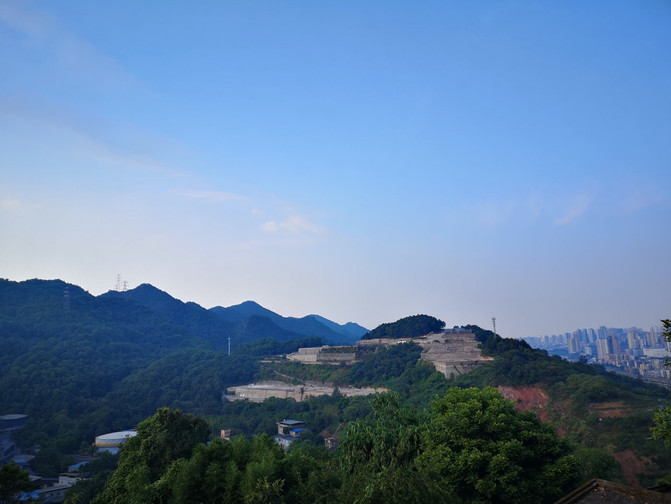
Huayan Zen Forest: Returning to a Peaceful Heart
Opening hours: 8:00-17:00
Ticket: Free
Vegetarian restaurant hours:
Monday to Friday: 9:00-20:30 Saturday to Sunday: 8:30-19:30 Per capita consumption: 67 yuan/person
Entering the ancient temple in the early morning, the sun shines high in the forest. The bamboo path leads to a secluded place, and the Zen house is filled with deep flowers and trees. The mountain light pleases the bird's nature, while the pool shadow empties the heart. All sounds are silent here, but there are still lingering bells and chimes.
After climbing down the mountain, I felt refreshed and decided to visit Huayan Zen Forest. It is said that there is a vegetarian restaurant in the temple where you can have lunch at noon. It only takes about 15 minutes by car to get there from here.
When we arrived at Huayan Tourist Area, we stepped into the Buddhist temple and our hearts became much quieter. It was like the gate of the temple, which isolated us from greed, anger, ignorance, and suffering in the world. It's just raining today. The carved beams and painted rafters Temple, lotus leaves and lotus flowers are silent when the rain soaks, but the bell sounds long.
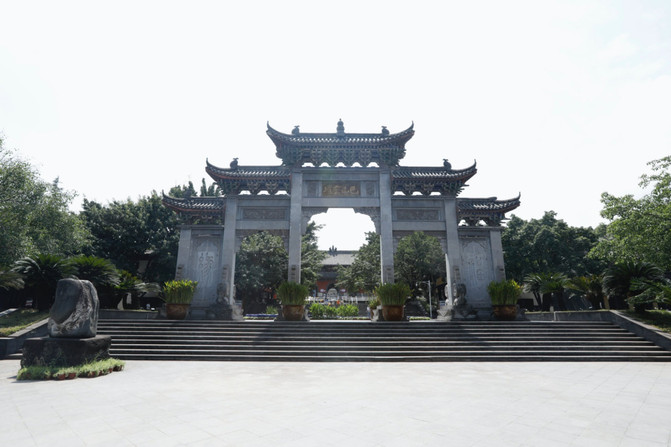
Huayan Tourist Area is located in Jiulongpo District, Chongqing, with convenient transportation and a long history. It enjoys the reputation of "Bashan Lingjing" and is a municipal level cultural relic protection unit and a lotus production and exhibition base in Chongqing. The whole tourist area is led by three building groups, namely, the the Shakya ManiHall, the Hall of Reception, and the Huayan Cave. It integrates the temple, lake, garden, forest, mountain, and cave. There are not only religious sites such as ancient temples, pagodas, stone carvings, sculptures, and ancient bridges in the scenic area, but also cultural landscapes such as the Tianchi Night Moon, Wanlin Songtao, and Yuanfan Xiao Bell. The entire park is lush with pine and bamboo trees, and is very secluded. Numerous literati and scholars from all dynasties have come in droves, visiting ancient times or monks to discuss Zen, leaving behind hundreds of poetry, calligraphy, and stone inscriptions.

The open-air golden Buddha statue of Shakyamuni Buddha stands peacefully in the middle of the square, with a total height of 20.8 meters. He lovingly waits for all sentient beings, for a moment on the mountain and a hundred years on earth. This is a holy land for praying and seeking blessings, with abundant incense and a large number of believers. On the first day of the Chinese New Year, there is a constant stream of devout men and women.
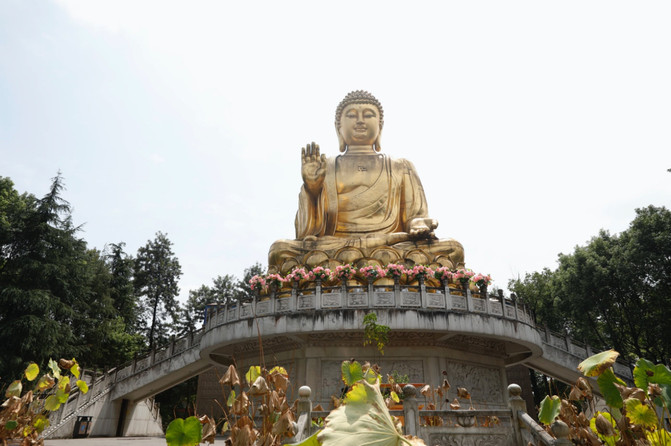
After worshiping Buddha, we arrived at the Seven Step Lotus Pond. Rare species such as Space Lotus No. 36 and Meitai Guanyin are planted here. It is said that August is the best season to appreciate lotus flowers, where you can see lotus flowers quietly nestled against the green and round lotus leaves, standing tall and elegant without being stained with dust. Many tourists and photography enthusiasts stop here to feel the subtle fragrance in the air. Cultivating lotus flowers in Buddhist temples seems to be guiding the public to experience a peaceful heart.
At noon, we dined at the vegetarian restaurant inside the temple and tasted vegetarian dishes such as Guoba rice, red bean soup, and "Spring River Water Warmth", which were fresh, refreshing, sweet, and delicious.
The entire temple has a spacious and peaceful environment, and visitors can leisurely slow down and feel the emptiness of returning.
Art Peninsula · "Comic" Tour HuangjuepingTicket: Free
Upon hearing the name 'Art Peninsula', one can surely feel the strong artistic atmosphere of the place we are going to this time.
Is it only artists who dare to be so 'capricious' and freely paint and express their creativity on a 1.25 kilometer long building complex?
Chongqing Art Park is part of the Yangtze River Culture and Art Bay Area, with the world's largest graffiti street. It is the birthplace of Sichuan Academy of Fine Arts, a contemporary art holy land and original base in China. Now, with the Huangjueping campus of Sichuan Academy of Fine Arts as the core, the industrial and cultural area of the power plant as the chain, and the ecological area of Jiulong Riverside as the pole, a boundaryless Chongqing Art Park is being created that allows citizens to participate widely.
Huangjueping Graffiti Art Street starts from Huangjueping Railway Hospital and ends at 501 Art Gallery, with a total length of 1.25 kilometers and a total area of about 50000 square meters. It is the world's largest group of graffiti art works and has become another business card and new landmark of Chongqing's fashion capital.


When we arrived here, we saw many young people checking in and taking photos as souvenirs. Every painting on the wall expresses the artists' sincerity and love for this city.
It is said that this graffiti art street project was created by Dean Luo Zhongli of Sichuan Academy of Fine Arts, and was created by Jiulong
Co created by the Po District Government and Dean Luo Zhongli of Sichuan Academy of Fine Arts. The entire graffiti project involved over 800 workers, students, and artists in production, costing 12500 kilograms of various paints and nearly 30000 brushes and oil brushes. After 150 days of meticulous production, a total of 37 buildings were graffiti painted, creating a unique artistic atmosphere unique to Huangjueping.
After the completion of Huangjueping Graffiti Art Street, the overall appearance of the block has undergone significant changes, while also creating a favorable environment for the development of cultural and creative industries, mainly led by Sichuan Academy of Fine Arts. There are often art festivals held here, which are lively and extraordinary.

After stopping at Huangjueping Graffiti Art Street for a while, we also went to the nearby Sichuan Academy of Fine Arts and Traffic Tea House for a spin. The lively and lively graffiti street scene contrasts sharply with the peaceful and comfortable tea house, and the combination of movement and stillness can better reflect the multifaceted nature of a city.
You and this city are not just a 'face to face' relationship.
on the third day
Hero's Residence: A Red Journey to Restore Our Original Aspiration
Opening hours: 9:00-17:30
Ticket: Free
Attention: The park is closed on Mondays.
Chongqing is a heroic city and the birthplace of red culture. Behind this mountain city, there is an impressive history of red revolution, and it has also nurtured a generation of revolutionary predecessors and great figures of the times.
The place we are visiting today is the hometown of revolutionary ancestor Zhou Gongzhi.
Zhou Gongzhi was a pioneer of the Communist movement in China. He was arrested for participating in the revolution, and despite the enemy's use of both soft and hard tactics, as well as threats and temptations, he remained steadfast in guarding the party's secrets and chose to die rather than surrender. In 1928, Zhou Gongzhi, along with nine Communist Party members including Fu Lie, Cheng Minghai, and Huang Zhongyuan, bravely died at the Shazui Execution Ground by the Chaotianmen Wharf in Chongqing. This year, Zhou Gongzhi was 29 years old.
The former residence is located in Zhoujia Dawan, Doushita Village, Tongguanyi Town, Jiulongpo District. It is a quadrangle courtyard facing north and south, with an area of over 1100 square meters. It consists of three courtyards: Chuxin Hall, Zhongxin Hall, and Chixin Hall, with blue tiles and white walls, dignified and elegant. Around the courtyard, there are orange groves and lotus ponds as companions, and the entire courtyard is located among the green mountains, secluded and peaceful.
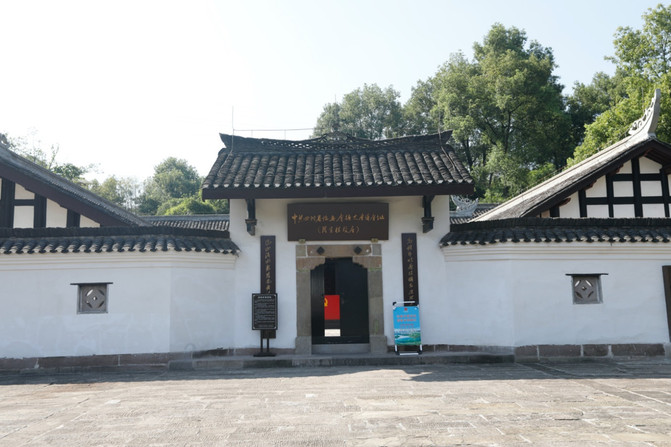
The former residence displays the glorious deeds of Zhou Gongzhi throughout his life. Through in-depth analysis of history, it enables people to never forget the difficulties of founding the country and always remember their own mission.
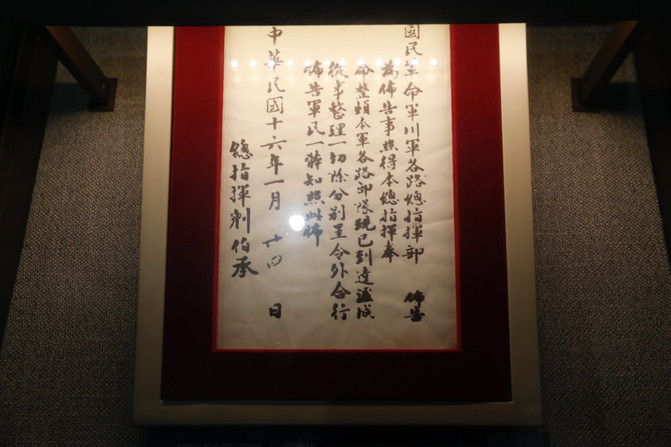

A short two-hour visit is actually not enough to fully understand the lives of our ancestors.
All the freedom and stability that this era has given us is just someone carrying the burden for us to move forward. This red journey has given us a deeper understanding of remembering our mission and staying true to our original intention.

Xipeng Aluminum City - One Aluminum Strip, One City
Xipeng Aluminum may be unfamiliar to tourists, but it holds a very important position in the economic strategic deployment of Jiulongpo and even the entire Chongqing.
Xipeng Aluminum is a provincial-level economic and technological development zone approved by the National Development and Reform Commission, and is one of the top ten industrial parks and top ten characteristic industrial parks in Chongqing. The park is adjacent to the golden waterway of the Yangtze River, at the junction of the "the Belt and Road" and the Yangtze River Economic Belt, and is an important fulcrum of the Chengdu Chongqing urban agglomeration. It is the "Capital of Aluminum Processing in China" jointly built by the Chongqing Municipal Government and China Aluminum Group.
The total planned area of the park is 65 square kilometers. With good transportation advantages and industrial city foundation, the park vigorously promotes the development of industries such as non-ferrous metal processing, new materials, intelligent and high-end equipment, and commercial logistics. It has initially built multiple "park within park" industrial clusters such as the melting and casting industry park, transportation aluminum industry park, and electronics industry park.

Among them, as a representative enterprise of Xipeng Aluminum, China Aluminum Industry Group High end Manufacturing Co., Ltd. is the largest and most complete aluminum processing gathering area in the industry chain, and can be called Chongqing's industrial business card. Its subsidiary Southwest Aluminum Group provides high-end aluminum materials for the "Long March", "Tiangong", "Shenzhou", "Chang'e" and other aerospace series, as well as national heavy objects such as the Tianyan and domestically produced large aircraft. By 2025, we will achieve the goal of 'double trillion yuan' in output value and market value.
At this point, we could only see the strict appearance of the park, with neatly arranged trees on both sides and wide and unobstructed roads. As it is an industrial park, it is not convenient to visit the company. Let's take a few aerial shots to let everyone experience the magnificent atmosphere of the industrial park.

Ticket: Free
Every time I visit the ancient town, there is a nostalgic feeling.
Perhaps influenced too deeply by 'Rain Lane', when visiting the ancient town, one always thinks of the long and quiet cobblestone road and the girl holding an oil paper umbrella.
When we arrived at Zouma Ancient Town, it happened to be noon. After having a meal at the restaurant in the ancient town, we also went to sit in a small tea house. Occasionally, pedestrians pass by the ancient town, but they are all quiet. The doors and windows of the stilted house were opened a few times, and one could vaguely see figures swaying inside. Unlike metropolises, ancient towns
The pace is very slow, suitable for coming here to daydream and relax.


I heard from the boss that in ancient times, Zouma Ancient Town was very prosperous. It was once a must pass place for Chongqing to Chengdu, with a constant stream of merchants coming and going, and it was very lively. Pedestrians brought various new things to Zouma Ancient Town, and countless folk songs, stories, and interesting anecdotes were created and passed down from generation to generation, forming a unique national intangible cultural heritage - Zouma Stories. There is a folk saying that goes, 'If you don't know your appearance, you'll be sad and walk away from the horse gate.'.

Zouma Ancient Town has a long history. If we trace back to its roots, it can be traced back to the Han Dynasty, in the mid Ming Dynasty
Starting to flourish. It belongs to Baxian in the north, Bishan in the west, and Jiangjin in the south, and is known as "stepping on three counties with one foot". Inside the ancient town, there are ruins of ancient post roads, ancient street areas, blacksmith shops, old tea houses, and ancient theater buildings from the Ming and Qing dynasties. In 2008, Zouma Ancient Town was named the fourth batch of "Historical and Cultural Famous Towns" by the State Council.
There are two theater buildings in the ancient town, one in front of Guanwu Temple and the other inside Yuwang Temple. During festivals and temple fairs, there are always theater troupes attending. Famous Sichuan opera masters such as Wu Xiaolei and Chen Shufang have performed here, and the people of the surrounding towns and villages gather here, with long and short plays flourishing. Created the title of "Hometown of Chinese Quyi" in Zouma Ancient Town.
Although the ancient town has been washed away, it is still able to preserve the most simple and peaceful atmosphere. Drinking tea, watching dramas, and listening to stories in the ancient town also has its own elegance.

Chongqing is a "magical city" with beautiful mountains and charming scenery, and its unique mountain city culture is fascinating.
Jiulongpo, as the "mountain city business artery" of Chongqing, not only has the title of "Jiangcheng Art Island", but also forges the humanistic spirit of "Nine Hearts Returning to One, Dragon Traveling Across the World", making it a thriving base for Chongqing's cultural and creative industries.
The "Nine Scenic Spots of Kowloon" not only possess the unique charm of a mountain city, but also represent the most distinctive cultural features of Kowloon Slope
Symbol.
Welcome to the "Nine Scenic Spots of Kowloon" sightseeing tour, experience a different Kowloon slope, and gain a brand new experience
The cultural and tourism experience.
Previous Article:Rain and Clear, Thick and Light, Unclassified Painting - A 16 Day Travel Diary of Enshi, Sichuan and Chongqing in 2021- The Land of Six Springs
